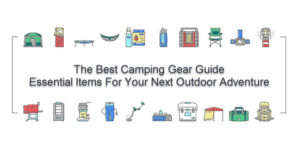Are you ready to embark on an adventure and sleep under the stars? If so, then choosing the right camping sleeping bag is essential. In this ultimate guide, we will cover everything you need to know about selecting the best camping sleeping bag for your needs.
Introduction to Camping Sleeping Bags
Camping sleeping bags are designed to keep you warm and comfortable while you spend a night or two in the great outdoors. They come in various sizes, shapes, materials, insulation types, and other features that make them suitable for different environments and weather conditions. The key to finding the perfect camping sleeping bag is identifying what matters most to you based on your preferences and needs.

Choosing the Right Size and Shape for Your Needs
The first step in choosing the best camping sleeping bag is determining the appropriate size and shape for your body type. You want to ensure that you have enough room to move around without feeling constricted but also not too much space where heat can escape. A general rule of thumb is to look for a sleeping bag that is at least six inches longer than your height. As for width, go for one that allows you to stretch your arms above your head comfortably. Additionally, consider if you plan on sharing your sleeping bag with someone else as some models are designed for couples.
Materials and Insulation Types

When it comes to materials, there are several options available such as cotton, polyester, and nylon. Cotton sleeping bags are lightweight, breathable, and soft against the skin; however, they tend to be less durable and not as effective at keeping you warm during colder temperatures. Polyester sleeping bags, on the other hand, offer better insulation, are more durable, and quicker drying after washing. Nylon is another popular material used in camping sleeping bags due to its strength, water resistance, and light weight.
In terms of insulation, there are three main types: synthetic, down, and hybrid. Synthetic insulation is made from man-made fibers and provides good warmth even when wet. Down insulation is made from duck feathers and offers excellent warmth-to-weight ratio, making it ideal for cold climates. Hybrid insulation combines both synthetic and down insulation, providing the benefits of each.
Rating Systems and Temperature Ratings
Another crucial factor to consider when buying a camping sleeping bag is the temperature rating. This refers to the lowest temperature at which the sleeping bag can keep you warm. Rating systems vary between manufacturers, but generally, they range from zero degrees Fahrenheit to fifty degrees Fahrenheit. To determine the correct temperature rating for your needs, think about the climate you’ll be camping in and how cold it can get at night. For example, if you’re planning on camping in a cooler environment, opt for a lower temperature rating.
Other Features to Consider
There are additional features to take into account when purchasing a camping sleeping bag. One important feature is the zipper style. Some sleeping bags have a full-length zipper that allows you to open it up completely for ventilation, while others have a half-zip design that still provides airflow but also keeps you securely inside. Other features include pockets for storing small items like phones or flashlights, hoods for extra warmth, and compression sacks for easy storage and transportation.
Conclusion
Finding the best camping sleeping bag may seem overwhelming, but by considering factors such as size, shape, materials, insulation, temperature ratings, and additional features, you can narrow down your search and find the model that suits your specific needs. Whether you’re a beginner camper or an experienced outdoor enthusiast, investing in a high-quality camping sleeping bag will enhance your camping experience and provide you with a restful night’s sleep under the stars.

